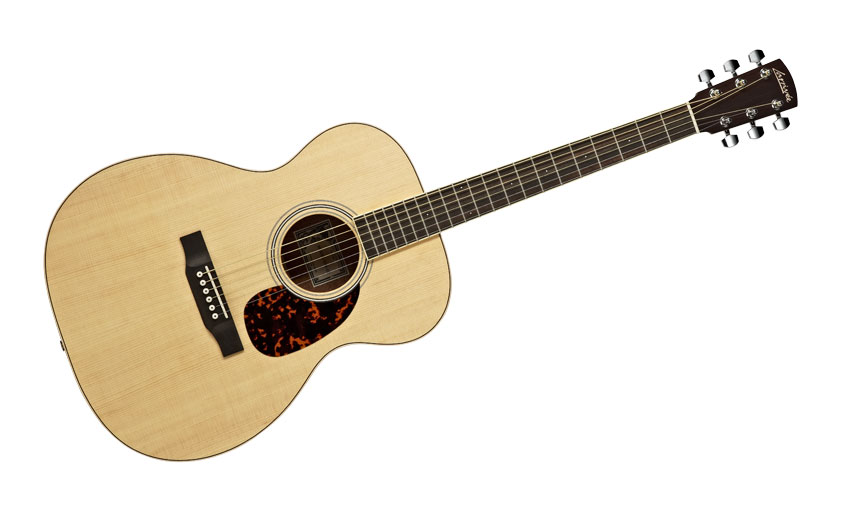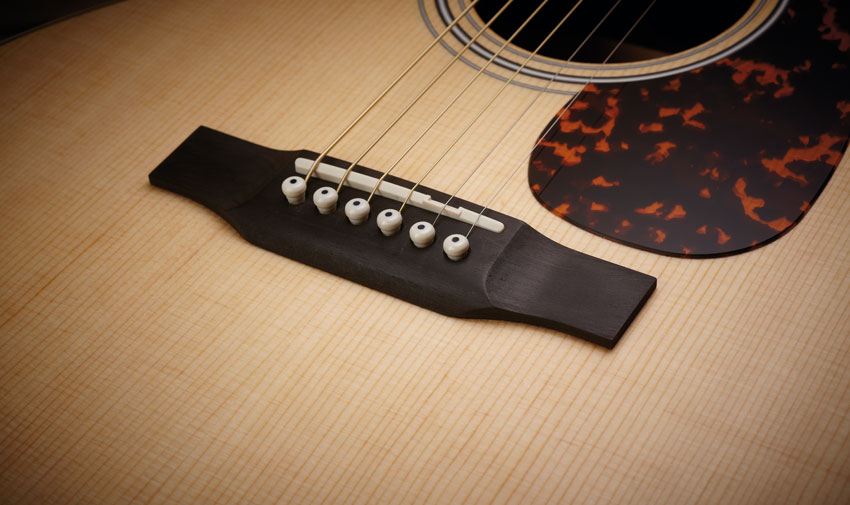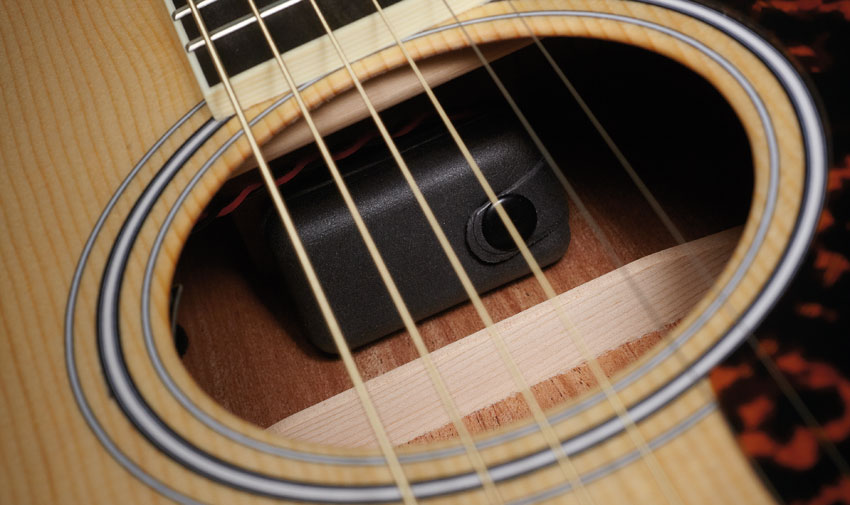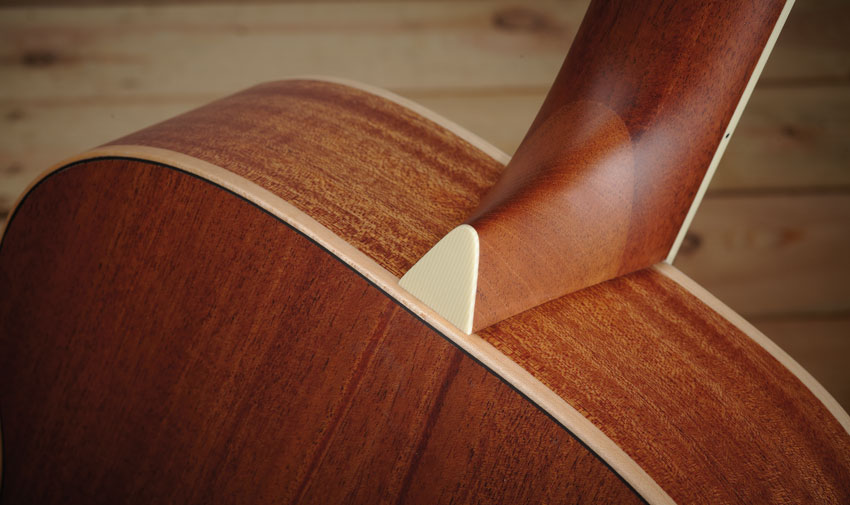MusicRadar Verdict
Built to a price it may be, but this is a very serious, characterful electro that proves way more versatile than its wide-spaced fingerstyle design suggests.
Pros
- +
Crisp, detailed build. Balanced acoustic tone. Flexible plugged- in voice.
Cons
- -
No cutaway option. Some will need more onboard control. No second strap button.
MusicRadar's got your back

Larrivée OM-02E

Bridge

Soundholes

Neck joint
Relaunched in 2011, Larrivée's 02 series was originally intended as an acoustic-only limited run, but has been ongoing in certain territories. The Canadian-made series is almost a sub-Larrivée brand, if you like - they don't appear on Larrivée's website.
But here in the depressed economy of the UK, the 02 series, now available in electro versions, virtually defines Larrivée. Although prices have risen since 2011, they remain excellent value, especially in comparison with the USA's big guns, Martin and Taylor.
Our review 14-fret OM-02E is one of three 02 body styles. Its 387mm (15.25-inch) lower body width closely follows Martin - the 'orchestra model' OM and the 000-14 have the same size body - although the width across the upper bouts is slightly broader.
"With 1.52 inches string spacing at the nut and a spacious spread at the saddle, there's plenty for the fingerstylist here"
The OM's nut width is slightly broader than the L or D at around 44.45mm (1.75 inches), compared with the L and D, quoted at 42.86mm (1.69 inches). With 38.5mm (1.52 inches) string spacing at the nut and a spacious spread at the saddle of 55mm (2.17 inches), there's plenty for the fingerstylist here - if you only need to belt out cowboy chords, you might want something less wide.
The compound radius of the fingerboard also lends a flat, almost classical feel to the higher registers, and the quite full-shouldered C-meets-D profile isn't the skinniest we've played. But this gives the guitar its own feel and style.
Above all, Larrivée's crisp, detailed build is superbly represented, especially with this thin natural satin finish: sloppy craft has nowhere to hide. The back and sides are African sapele, with a muted red colouration contrasted by the ultra-clean Canadian maple binding with a simple contrasting black purfling.
The three soundhole rings are the only decoration, and they're classily austere. Although we have clear black dots on the grained ivoroid fingerboard binding, the micro-dot fingerboard inlays might as well not be there - they pretty much 'disappear' in the playing position.
The Sitka spruce top is very clean, too, with a wide, bold grain that may well be a lower grade than that used on the upper-market guitars; but judging sound quality from visual appearance is a dubious practice. Internally, it's all shipshape, and uses Larrivée's symmetrical X-bracing.
The neck is hand-fitted to the body with a traditional dovetail joint but, unlike on the 03 range upwards, the main spine of the neck is a three-piece laminate. It's very well jointed, barely visible, and although it's likely included so thinner sections of mahogany can be used, it's hard to see it as a bad choice-many guitars out there, often at much higher prices, use laminated necks for stability over unlaminated one-piece styles.
There's only one cutaway in the 02 electro range, and unlike the 03, the powering here is from Shadow, not LR Baggs, with the Nanoflex under- saddle pickup plus discrete volume and tone rotary controls placed on the inside rim of the soundhole. "Unlike average bridge pickups," says Shadow, "Nanoflex pickups take up the vibrations of an instrument's strings and body. NFX pickups therefore give rise to a sound spectrum more closely resembling a microphone/ bridge pickup combination."
Oddly, despite its electro intention, we only have a single output jack/strap button. The battery compartment is inside the guitar, too - not the easiest position for a mid-gig battery swap. Mind you, the rest of the package - including the robust, classy hardcase - more than makes up for those negatives.
Sounds
"Here's a guitar that we suspect can be quite a chameleon"
Here's a guitar that we suspect can be quite a chameleon. There's a very good balance, acoustically, a slightly mid- scooped dreadnought with a trimmer, tighter low-end. It requires you to dig in a little - no bad thing for a more experienced player - and the neck shape and fingerboard radius lend a specific feel to the guitar that might be a little hardcore for some.
Yet as a fingerpicker or hybrid-picker, you'll feel very at home, especially if you find the more electric-like neck sizes of numerous modern acoustic brands too cramped and skinny.
Amp'd, we don't have much in the way of control, but it's the tone control that's key: at one end of its travel there's more than enough modernist sparkle, but as you turn the control down it shifts to a bassier voice with more midrange. So, setting it for your preferred tone, which can only be done by feel, is crucial in getting the start of your sound.
Certainly, with the tone knocked back a bit there's a little more Taylor ES-like tonality, a little modern soundhole pickup, even. Unfortunately, the B string is a little hot in terms of output, but that aside, once you've found that sweet-spot balance between highs and lows, it's an impressive performance: with a less piezo-like quack, and we'd agree, more 'microphone' to the tone, but seemingly much more feedback-resistant than having an internal mic onboard.
There's no built-in tuner, or any feedback-busting notch filter or phase switches, which experience tells us means you're going to need some help, perhaps from an external preamp. That said, for solo or duo work, especially in a decent-sized venue, you're going to get a pretty good straight-in tone.
"There's plenty to like here: the all-solid-wood traditional construction, the price and the unobtrusive onboard electrics"
This is a guitar that takes a little time to get familiar with to really find its voice, certainly amplified. But find it we did, and it proves highly addictive, ploughing a path between more modernistic ultra-crisp voices and something a little dirtier and vintage-sounding. In a very broad sense, thinking it lies midway between the perceived darker Martin and clearer Taylor tonality would be a good starting point.
There's plenty to like here: the all-solid-wood traditional construction, the price and the unobtrusive onboard electrics. For players needing a cutaway, there's only one electro choice - the original Larrivée-shaped LV-02E - and depending on your gig it's not the most equipped electro out there.
It seems to us it's more for the acoustic player who does the occasional gig. But that's by no means a bad thing, and do remember that the acoustic version of the same guitar is even more attractive price- wise, if you wanted to amplify it at a later stage.
But what Larrivée has over both Taylor and Martin is an all-wood specification, at a price neither of the big boys can quite match. To our eyes and ears, it seems more 'finished', too. In short, it's a lot of guitar for the money.
Dave Burrluck is one of the world’s most experienced guitar journalists, who started writing back in the '80s for International Musician and Recording World, co-founded The Guitar Magazine and has been the Gear Reviews Editor of Guitarist magazine for the past two decades. Along the way, Dave has been the sole author of The PRS Guitar Book and The Player's Guide to Guitar Maintenance as well as contributing to numerous other books on the electric guitar. Dave is an active gigging and recording musician and still finds time to make, repair and mod guitars, not least for Guitarist’s The Mod Squad.
“We were arguing a lot and we were miserable”: How Green Day exceeded expectations with their most ambitious song
"There’s plenty for us guitarists to learn – and ‘less is more’ is the overriding lesson": how to play like George Harrison on The Beatles' Abbey Road
“They didn’t like Prince’s bikini underwear”: Prince’s support sets for the The Rolling Stones in 1981 are remembered as disastrous, but guitarist Dez Dickerson says that the the crowd reaction wasn’t as bad as people think










